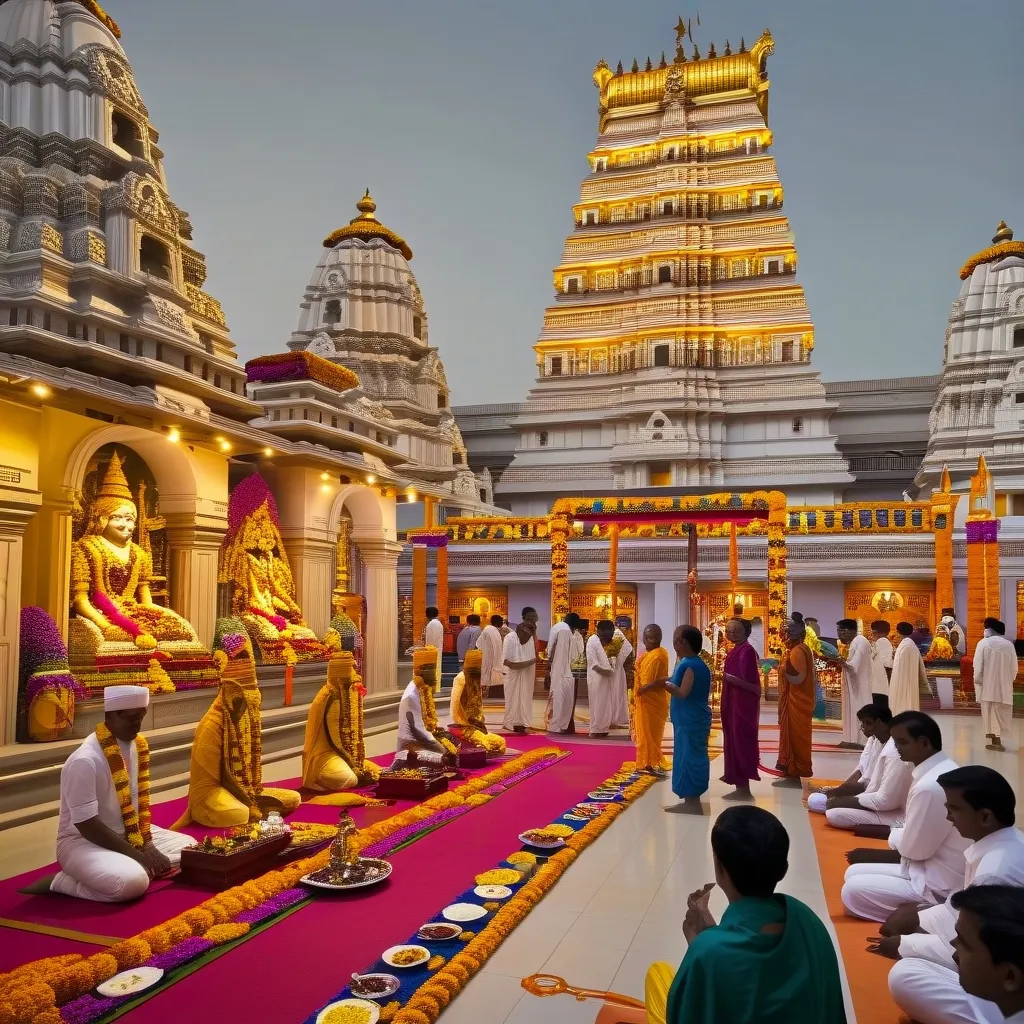Hindu temples are more than just places of worship. They’re vibrant hubs of spiritual, cultural, and community life, pulsating with age-old traditions and deep symbolism. Let’s dive into the fascinating world of Hindu temple rituals and practices.
At the heart of temple worship is the puja ceremony. Picture this: a priest, known as a pujari, stands before the altar, ready to invoke the divine. The air is thick with anticipation as he lights the sacred flame, the aarti. The soft glow illuminates the temple, symbolizing the divine light that dispels darkness. Suddenly, the silence is broken by the ringing of a bell and the blowing of a conch shell. These sounds aren’t just for show - they’re believed to purify the space and call forth the deity.
Now, imagine the pujari offering beautiful jasmine garlands and fresh fruits to the deity. It’s like throwing a party for a cherished guest, isn’t it? The pujari even fans the deity with a flywhisk, treating them like royalty. This isn’t just empty ritual - it’s a demonstration of total love and devotion, or bhakti as it’s called in Sanskrit.
But the real magic happens during darshan. This is when devotees and the deity lock eyes in a mutual gaze. It’s an intensely personal moment, like looking into the eyes of a loved one and feeling a deep connection. For many Hindus, this is the highlight of their temple visit, a moment that strengthens their bond with the divine.
After the puja, comes everyone’s favorite part - prasad! This is food that’s been blessed by the deity. The pujari distributes it along with holy water called theertham. It’s not just a snack - eating this blessed food is believed to nourish the soul. Plus, it’s a great way to bring the community together. There’s something special about sharing food that’s been touched by the divine, don’t you think?
The ritual wraps up with parikrama - walking around the altar. It’s like saying, “God, you’re at the center of my universe.” This simple act carries deep meaning, symbolizing the completeness that the divine brings to our lives.
Now, let’s take a quick trip back in time to the Udayagiri Caves in Madhya Pradesh. These ancient caves, reworked under Emperor Chandragupta II, were a hub for imperial rituals during the Gupta period. The caves are adorned with sculptures of various avatars of Vishnu, offering a glimpse into the early development of Hindu practices.
But Hindu temples aren’t just about rituals - they’re architectural marvels too. Take the Depot Road Temple in Durban, for instance. Modeled after a temple in Varanasi, it boasts a wide verandah, an inner court, and a sanctuary topped with a white dome. The dome isn’t just for show - it’s decorated with bas-relief representations of various deities, making it a feast for the eyes and the soul.
Temples have always been more than just places of worship. In ancient times, they were centers of learning and cultural exchange. This tradition continues today. Modern temples, like the BAPS Swaminarayan mandir in New Jersey, are community hubs where people from all walks of life can engage with Hindu theology, culture, and community.
These temples offer a smorgasbord of activities - from educational programs to social events. They’re not exclusive clubs for Hindus - they’re welcoming spaces for everyone. Imagine celebrating your birthday at the BAPS mandir, surrounded by friends and family of all backgrounds, all marveling at the architecture and participating in rituals like the aarti.
Temple rituals aren’t confined to the main altar. They spill over into various spaces within the temple complex - tanks, courtyards, and mandapas (pillared halls). Each space has its own significance and hosts different ceremonies. The tanks, for instance, are often used for abhisheka - the ritual washing and anointing of the deity with milk, honey, oil, and rosewater. It’s a beautiful act of devotion, like lovingly bathing a cherished idol.
Festivals bring temples to life in a whole new way. During Diwali, the festival of lights, temples are abuzz with grand ceremonies and communal worship. The Hindu New Year is another big celebration, filled with rituals, food offerings, and cultural events. These festivals are like family reunions, bringing the community together in joyous celebration.
As times change, so do temple practices. Younger Hindus are increasingly drawn to the philosophical and spiritual aspects of their faith rather than traditional rituals. Temples are adapting to this shift, offering more educational and cultural programs. Some temples, like the Hindu Temple of Minnesota and the Sri Siva Vishnu Temple in Maryland, are becoming more open and inclusive. They offer guided tours and explain the philosophy behind Hindu worship, helping to demystify the faith for a broader audience.
What makes Hindu temple rituals truly special is the personal touch and community engagement they offer. Whether it’s the pujari distributing prasad with a smile or devotees singing devotional songs together, every aspect of temple worship is designed to foster a sense of belonging and spiritual connection.
For many Hindus, visiting the temple is like coming home. It’s a place to find peace, seek blessings, and celebrate life’s milestones. It’s where they reconnect with their roots and their community. In a world that often feels disconnected, temples offer a space for meaningful connection - with the divine, with others, and with oneself.
In essence, Hindu temple rituals are a vibrant tapestry of spiritual practices, cultural traditions, and community engagement. From the ancient Udayagiri Caves to modern marvels like the BAPS Swaminarayan mandir, these rituals continue to play a vital role in the lives of Hindus worldwide. Whether you’re a devout follower or simply curious about Hinduism, these temples offer a welcoming space to explore, learn, and connect with something greater than ourselves.
So next time you pass by a Hindu temple, why not step inside? You might just discover a world of beauty, spirituality, and community that you never knew existed. Who knows? You might even find a piece of yourself in the process.






